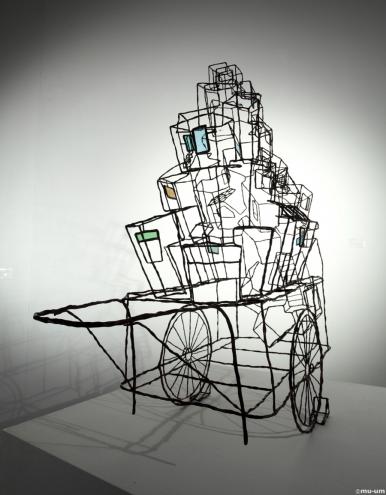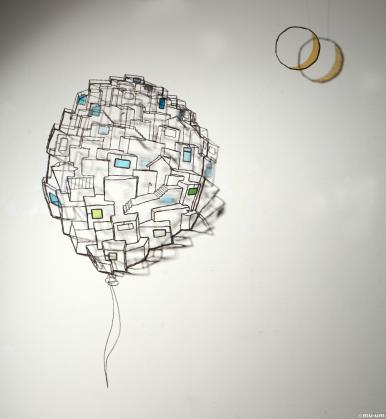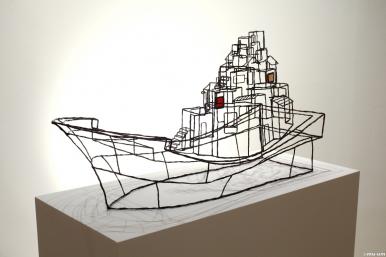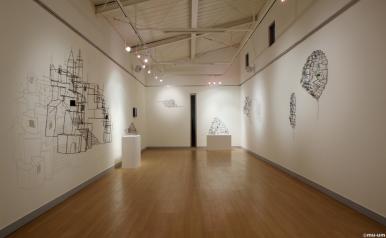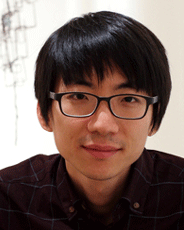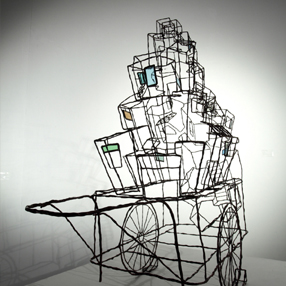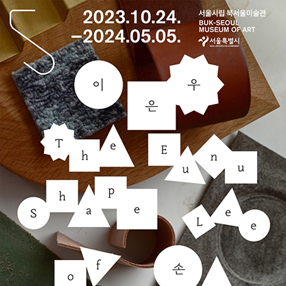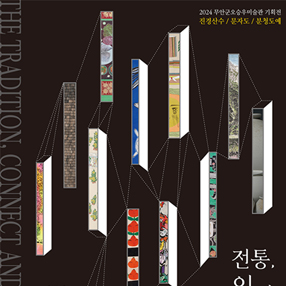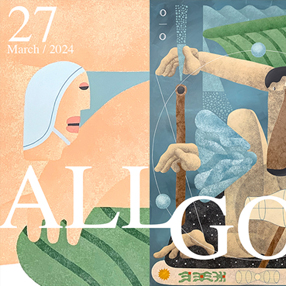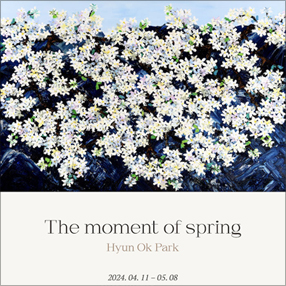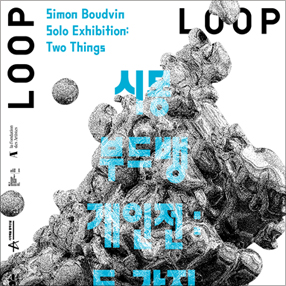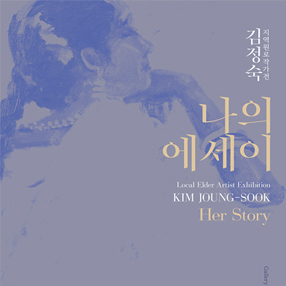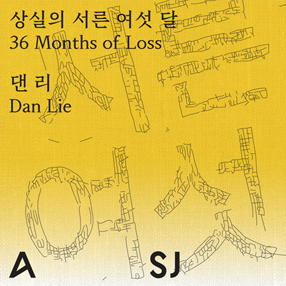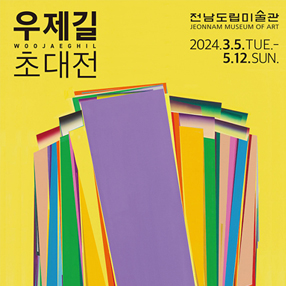본문
-
모준석
우리의 여정 동선, 스테인드글라스, 74x80x3cm, 2011, 개인소장
모준석
하늘에 속한 이들 동선, 스테인드글라스, 25x66x87cm, 2011, 개인소장
모준석
키를 맡기고서 동선, 스테인드글라스, 36x70x28cm, 2011
Press Release
모준석의 케노시스
서성록
골목 사이로는 계단이 나 있고 가로등이 보초처럼 우두커니 서 있다. 조그만 집채들이 다닥다닥 붙어있는 게 전형적인 달동네 풍경을 닮아 있다. 그의 작품을 보는 순간 이처럼 유년기의 나날들이 엉켜서 꿀벌처럼 귓가에 잉잉거리는 것같은 느낌을 받았다. "나는 유년시절부터 잦은 이사를 다니며 집을 옮겨 다녔다. 그때마다 타자라는 새로운 공간과 직면해야 했다. 새로운 집과 환경에 적응하기 위해 나의 짐들을 버려야 하기도 했고, 삶을 환경에 맞추어야 했다."(작가노트중에서)
울산 태생인 모준석은 작품을 통해 집을 짓는다. 고향을 떠나온 사람에게 집이란 늘 향수로 가득한 곳이자 회귀의 장소이다. 그러나 작가가 이런 소박한 의미로 집을 형상화하고 있는 것은 아닌 것 같다. 거기에는 보다 특별한 의미가 실려 있다. 그에 의하면, "집이라는 곳은 --- 사람과 사람을 가르는 공간이 아닌 사람들과 만나는 공간 그리고 경계나 소유의 공간이 아닌 소통의 공간이다." 만남과 소통의 상징물로 집을 기용하고 있다는 얘기다. 그의 작품을 보면 모든 집들이 가느다란 선으로 연결되어 있다. 매스자체를 없애버리고 선으로만 형체를 잡은 것이다. 선을 사용한 데는, 징검다리가 이쪽과 저쪽을 이어주듯이, 개체와 개체의 연결, 사람과 사람 사이를 이어주려는 의도에서 비롯된 것 같다. 그는 연결되는 선을 통해 바람직한 공동체의 이상을 나타내고 있다. 그것을 작가는 코이노니아(koinonia)라고 부르는데 그것의 원뜻은 '그리스도의 몸과 하나되는 교제'라는 의미를 지니지만 여기서는 사람들의 하나됨을 일컫는다. 하나됨은 평화없는 세상에 '참된 평화'가 심어지는 것을 일컫는다. 사실 우리 사회는 경쟁의 논리는 있지만 평화의 논리는 부재하다. 평화의 논리가 부재하기 때문에 서로를 격리시키고 때로는 헐뜯는다. 전쟁은 전장에서만 일어나는 것이 아니라 우리의 일상에서 매일, 매순간 일어나고 있다. 그의 평화의 논리는 거의 모든 작품에 적용되지만 가장 현저한 작품은 「하나가 되어주세요」란 작품이다. 여기서는 집들이 써클을 이루며 둥그스름하게 자리하고 있다. 마치 사람들이 단오절 밤에 손을 잡고 강강수월래를 외치며 빙빙 도는 것 같은 포즈이다. 이 작품에서 더 이상 개체는 존재하지 않는다. 개체들은 이미 한 덩어리가 되어 단단하게 결속되어 있다. 서로를 이해하고 용납하는 모습을 형용한 작품이다.
「에클레시아」도 같은 맥락의 작품이다. 이 작품에선 결집이 더욱 강화되는데 어느 한군데 빈틈없이 아귀가 맞추어졌음을 볼 수 있다. 수직과 수평의 선들, 굵고 작은 선들이 짜임새 있게 전체의 계획에 맞게 틀지어져 있다. 골목사이의 계단에서부터 수평의 지붕이나 세모꼴 지붕, 여러 모양의 창까지 정교하게 구성되어 있다. 이런 형체가 전체적으로는 원형구조를 이루고 있는데 이 또한 서로를 받아들이고 포용한다는 의미를 함축하고 있다. 「한마음」에서도 그런 흔적이 뚜렷이 나타난다. 전체적으로 피라미드 구조를 하고 있는 이 작품에선 정면에 정상으로 올라가는 길이 나있고 주위에는 박스같은 집채들이 빼곡하다. 을씨년스런 달동네를 표현한 것 같지만 실제로는 너와 나의 경계없는 세상을 표현한 것이다. 선이 마을 전체를 연결시키고 있는데 사람으로 치면 몸 구석구석에 혈액을 공급하는 동맥 역할을 하고 있는 셈이다.
그의 작품에 심장역할을 하는 또 다른 키워드는 케노시스(kenosis)란 개념이다. 이 역시 성경에서 비롯된 개념으로 우리말로 번역하면 자기비움, 그러니까 "자기를 비워 종의 형체를 가지사 사람들과 같이 되었다"(빌 2:7)는 성육신의 신비에서 비롯된 용어이다. 헬라어인 에케노센(ekenosen)에서 케노시스라는 개념을 차용, 신학적으로 발전시킨 용어인데 신의 겸손(Humility)을 일컫는 기독교의 주요한 개념으로 받아들여지고 있다. 그의 작품에서 케노시스는 공간을 비우는 것에서 볼 수 있다. 보다시피 그의 작품은 텅 비어 있다. 선을 유난히 강조했기 때문이라고 분석되지만 사실은 그의 작품은 속을 비워낸, 말하자면 진공의 조각이라고 할 수 있다. 우리가 보는 것은 부피를 지닌 실물의 이미지가 아니라 거푸집의 이미지인데 몸체를 감싼 윤곽, 그것도 수평과 수직으로 직조한 구조물을 보는 셈이다. 앙상한 철골로 되어 있지만 마을의 풍정(風情)만큼은 누구보다 잘 살려내고 있다. 속이 비었다는 것은 그에게 자신의 마음과 주장을 비워내 한걸음 물러선다는 것을 말한다. 그렇게 해서 타인과의 교감을 형성하며 폭넓은 소통체계를 마련할 수 있다고 믿는 것이다. 「서로에게 속한 사람들」, 「당신과 걷는 길」, 「자기비움」, 「당신에게 가는 길」, 「동행」, 「한몸」, 「우리의 여정」 등 전작이 속이 비어 있다. 그러나 자기비움이라는 것이 말처럼 쉬운 것은 아니다. 자기비움이라는 것은 타인을 받아들이고 책임을 지며 그를 대신해서 짐을 지는 것까지를 내포한다. 케노시스는 이타심의 발로이며 이를 위해 자신의 낮아짐마저 감수한다. 이런 사실을 상기한다면 자기비움이란 피상적으로 허울 좋은 말이 아니라 자신의 살을 깍지 않으면 실로 도달하기 어려운 경지로 이해된다. 최후의 순간을 대비하기 위해 감람산에서 혼신을 다하여 기도하신 그리스도가 그러했듯이 온전한 자기비움에 이르려면 자기와의 싸움을 치르지 않으면 안된다.
그의 작품에서 치열한 내면과의 싸움은 「우리는 공사중」이란 작품에서 두드러진다. 이 연작에선 다듬어지지 않은 동선이 돌기(突起)처럼 삐죽 튀어 오르거나 옆으로 날카롭게 삐쳐 나와 있다. 앞에서 살펴본 작품들이 곱상하게 처리된 것과는 현저히 다른 느낌이다. 곳곳에 장애물이 매복하고 있어 까닥하다가는 찔리거나 손이 베일 수도 있다. 작가는 왜 이렇게 표면을 처리했을까? 그것은 앞에서 잠시 언급한 자기 비움의 고충을 암시하기 위해서가 아닐까 짐작된다. 작가는 고분고분 길들여지지 않는 자아를 뒤틀리고 날선 철골로 표상하고 있다. 그리하여 자신을 비워내어 타인과 소통하는 태도를 취하는 것이 얼마나 힘든 일인지 보여주고 있다. 때때로 중도에 포기하고 싶은 욕망이 굴뚝같지만 그대로 주저앉을 수만은 없을 것이다. 연단을 통해 더 강해진다는 말이 있듯이 여러번의 시험 끝에 더욱 강고(强固)해진다. 이렇게 볼 때 궁극적으로 자기 비움이란 희생이고 더 높은 가치로의 비상을 위한 발돋움이라고 할 수 있을 것이다.
필자는 그의 작품을 보면서 처음에는 서민의 애환을 담은 것으로 이해했었다. 그러나 작품에 가까이 다가설수록 심오한 이야기를 함축하고 있음을 알 수 있었다. 모준석은 지향해야할 목표를 잃어버린 우리 사회에 경종을 울리는 것 같다. 이 땅에 '참된 평화'를 구현하려면 타인에 대한 애정과 더불어 내안에 타인의 자리를 마련해야 한다는 것을 알려주고 있다. 그의 작업이 정교한 논리로 무장하거나 요란한 구호를 내세운 작품보다 진솔하게 다가오는 것은 이 시대에 꼭 필요한 실천적 철학을 환기시키고 있기 때문이다. 나를 위한 비움이 아니라 타자를 받아들이기 위한 비움이기에 더욱 빛나 보인다.
Mo Jun-Seok's Kenosis
Seo Seong-Rok
There are stairs between alleys and street lamps stand still like sentries standing guard. Tiny houses are all clustered together like a typical poor hillside village. When I saw his work, I felt like a honeybee was buzzed around my ear reminding me of my childhood. "When I was young, my family moved from one city to another very often, and I had to adapt myself to new circumstances. Sometimes I had to give up some valuable things for me to adjust my life to the new environment." (from the artist's note) Born in Ulsan, Mo Jun Seok builds houses through his artworks. For people who have left their hometowns, their homes are the places of return and nostalgia.
However, I think his work has more purposes than that. It has a special meaning. According to him, "A house is a place for meeting, not for cutting a person off from others, a place for communication, not for a boundary or possession." This means he consider a house a symbol of meeting and communication. In his work, all houses are connected by very thin lines. He creates all shapes through lines. I think he used lines to connect an object with others and a person with others like stepping-stones connect a side of a river with the other side. He shows desirable ideals of a community through the connected lines. He calls it 'koinonia', which means 'the oneness with Christ'. In his work, this word especially means the oneness between people. Oneness means 'a true peace' in our peaceless world. In fact, our world is the world of competition, not of peace. In this peaceless world, we separate ourselves from others and sometimes speak ill of others. Wars occur in our everyday life as well as in battlefields. We can see his idea of peace in almost all his works, but the best work that represent his idea of peace is 「Please, Become One.」 In this work, all houses make a circle like people hold hands and whirl around in the same limited circle. In this work, no individual exists. All individuals are strongly united into one, showing that all of them understand each other. The work titled 「Ecclesia」 can be understood in the same context. In this work, he shows the unification more strongly by perfectly piecing together all the corners. All vertical/horizontal and thick/thin lines are arranged perfectly according to the plan. All details from stairs between alleys to flat or triangle roofs and various types of windows are arranged elaborately. All these shapes make a circle and this means that all people understand and embrace others. The work titled 「One Mind」 also shows this idea. This work has a pyramidal shape. In front of work, you can see the road to the top and a lot of box-shaped houses along the road. At first, it looks as if he expressed a gloomy poor hillside village, but, in fact, this work shows a borderless world between people. A lot of lines connect the entire village like arteries that supply blood to every part of a human body. We should pay attention to another major keyword, 'kenosis', which also comes from the bible. This means self-emptiness like the bible says, "Instead he gave up everything and became a slave, when he became like one of us. (Phil. 2:7)" Kenosis that came from an ancient Greek work ekenose has become one of the major concepts of Christianity that menas the humility of God. In this work, he expresses Kenosis by emptying the space. As you see, the space is empty. This is maybe because he especially emphasizes lines, but, in fact, this work is, so to speak, a sculpture in a vacuum. We can see the image of a mold without any volume, not the image of a real work. We can see only the vertical and horizontal outlines of a structure. Although the structure consists of thin steel frames, it shows the landscape of a village very well. For him, emptiness means taking a step backward and emptying himself. He believes that, by doing so, he can contact and communicate with other. A lot of his previous works like 「People Who Belong To Each Other」 「Walking With You」,「Self-Emptiness」, 「On My Way to You」,
「Going With You」, 「Oneness」 and 「Our Journey」 shows emptiness. However, self-emptiness is not easy. To empty yourself, you should accept others, take responsibility for others and even carry other people's loads on your back. Kenosis represents altruism, and it requires you to humble yourself. Therefore, we need to understand that we cannot empty ourselves without taking excruciating effort to reach Kenosis. Like Christ who prayed with all His soul and might on the Mount of Olives for the last moment, we must win battles with ourselves to reach Kenosis. We can especially see his battle with himself in his work titled 「We Are Under Construction」. In this work, we can see unfinished copper wires poking out of the structure like bumps, while, in his previous works, they are arranged delicately. There are a lot of obstacles in this work, and you can be pricked or get a cut on your finger. So why did he do this? I think he wanted to express the difficulty of self-emptiness. The distorted and sharp steel frames symbolize his untamed ego. He shows us how difficult self-emptiness and communication with others is. You want to give up without completing your self-emptiness, but you cannot give it up. No pain, no gain. You will be stronger after training. Therefore, self-emptiness ultimately means self-sacrifice and standing on tiptoe for higher values. At first, I thought that his works aimed at expressing the hard life of ordinary people. However, I finally understood he has a lot of deeper stories to tell us. I think Mo Jun-Seok wanted to sounded an alarm about our world that goes without any desirable purpose. He tells us that we need to show our love to others and give others a place in us. For me, his works look more honest than any other works that have an elaborate logic or shout loud for a slogan because his works remind me of an essential and practical philosophy for our world. His works shine more brightly because they say the emptiness for others, not for myself. Seo Seong-Rok전시제목모준석 - 한걸음씩 다가섬 전
전시기간2011.11.10(목) - 2011.12.09(금)
참여작가 모준석
초대일시2011-11-10 16pm
관람시간10:00am~18:00pm
휴관일없음
장르회화와 조각
관람료무료
장소한국미술관 HanKuk Art Museum (경기 용인시 기흥구 마북로 244-2 )
연락처031-283-6418
Artists in This Show
1984년 울산출생
Current Shows




